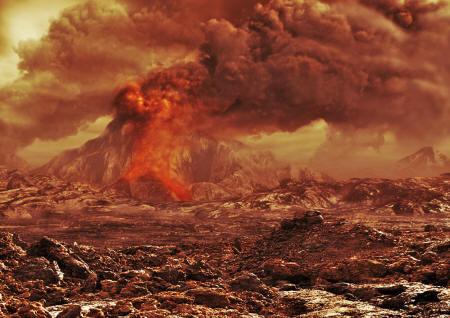|
by Charles Q. Choi
from
Space Website
An artist's rendition of a cloudy super-Earth. Scientists suspect that alien life could potentially thrive
on an alien planet by
subsisting on "supercritical" carbon dioxide instead of water.
This "supercritical"
carbon dioxide (CO2),
which has features of both liquids and gases, could be key to
extraterrestrial organisms much as water is to biology on Earth.
While it can exist as a solid, liquid
and gas, past a critical point of combined temperature and pressure,
carbon dioxide can enter
a "supercritical" state. Such a
supercritical fluid has properties of both liquids and gases. For
example, it can dissolve materials like a liquid, but flow like a
gas.
This is about equal in pressure to that found nearly a half-mile (0.8 kilometers) under the ocean's surface. Supercritical carbon dioxide is increasingly used in a variety of applications, such as decaffeinating coffee beans and dry cleaning.
See "Ten
Exoplanets that Could Support Alien Life".
Strange possibility for life
Ordinarily, carbon dioxide is not considered a viable solvent to host the chemical reactions for life, but the properties of supercritical fluids can differ quite significantly from the regular versions of those fluids - for instance, while regular water is not acid, supercritical water is acidic.
Given how substantially different supercritical carbon dioxide is from regular carbon dioxide in terms of physical and chemical properties, scientists explored whether it could be suitable for life.
The researchers noted that enzymes can be more stable in supercritical carbon dioxide than in water.
In addition, supercritical carbon dioxide makes enzymes more specific about the molecules they bind to, leading to fewer unnecessary side reactions.
Surprisingly, a number of species of bacteria are tolerant of supercritical carbon dioxide. Prior research found that several different microbial species and their enzymes are active in the fluid.
In addition, exotic locales on Earth support the idea that life can survive in environments rich in carbon dioxide. Previous studies showed that microbes can live near pockets of liquid carbon dioxide trapped under Earth's oceans.
This liquid carbon dioxide in the seafloor gets denser with greater depth, as the weight of the seas and rock above it increases.
As that happens, the fluid could become supercritical, and microbes might use at least some of the biologically advantageous properties of this supercritical carbon dioxide to survive, Dirk Schulze-Makuch said.
Indeed, there may be many reservoirs of supercritical carbon dioxide under the oceans, he added.
An artist's rendition of the surface of Venus with an erupting volcano. Credit: ESA/AOES
Was Venus a supercritical haven?
Since carbon dioxide is a very common molecule in planetary atmospheres, the researchers suggest that supercritical carbon dioxide may be present on many worlds.
This is especially true for Venus, whose atmosphere is mostly carbon dioxide.
In its early history, Venus was located in the sun's habitable zone, the area where liquid water can form on a planet's surface. Life as it is currently known could have developed there before Venus heated up enough to lose all its water.
Although Schulze-Makuch said it was unlikely that any such life could have switched from water to supercritical carbon dioxide, perhaps some organic remnants of such life, if it existed, could have been preserved in that fluid.
Beyond the solar system, Schulze-Makuch noted that many newfound planets orbiting distant stars are so-called super-Earths, worlds up to 10 or more times the mass of Earth. Under the stronger gravitational pulls and correspondingly higher atmospheric pressures of those planets, supercritical carbon dioxide might be common, he said.
Although Schulze-Makuch noted there is no proof that life that does not depend on water is possible,
Schulze-Makuch and his colleague Ned Budisa detailed their findings in the September issue of the journal Life.
|


